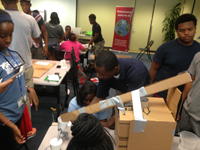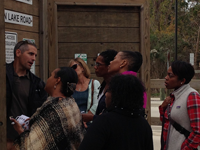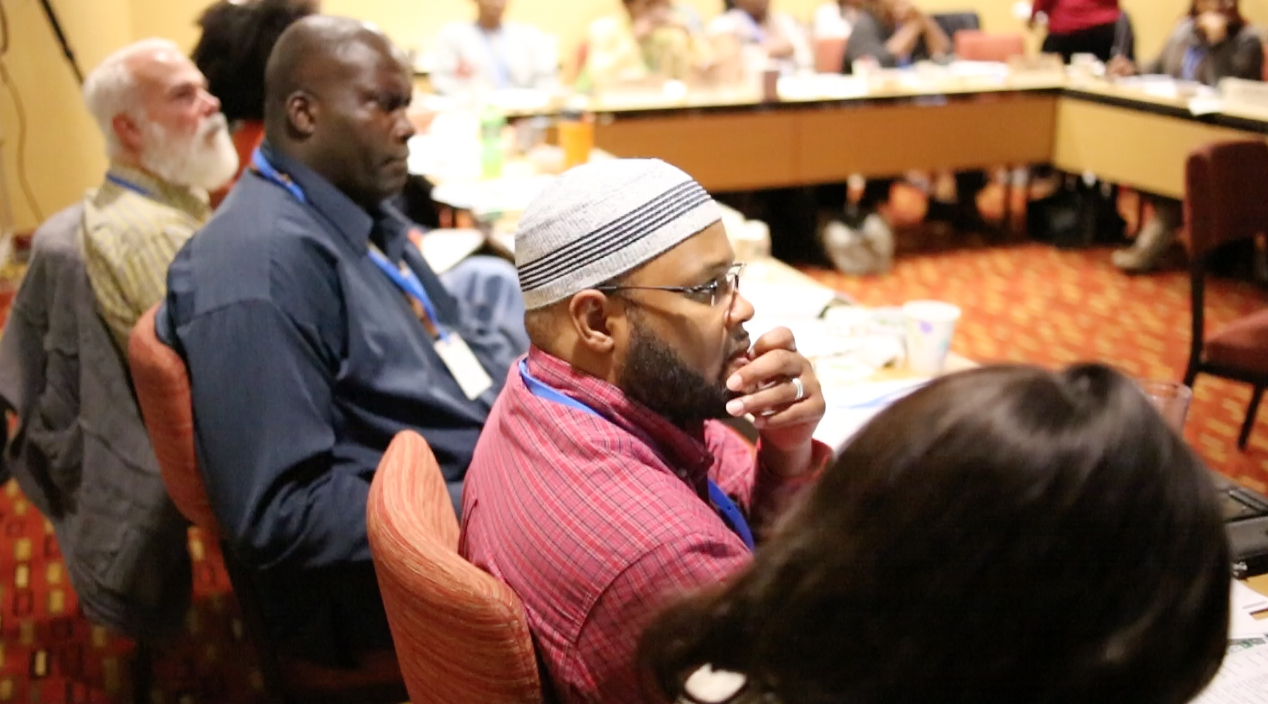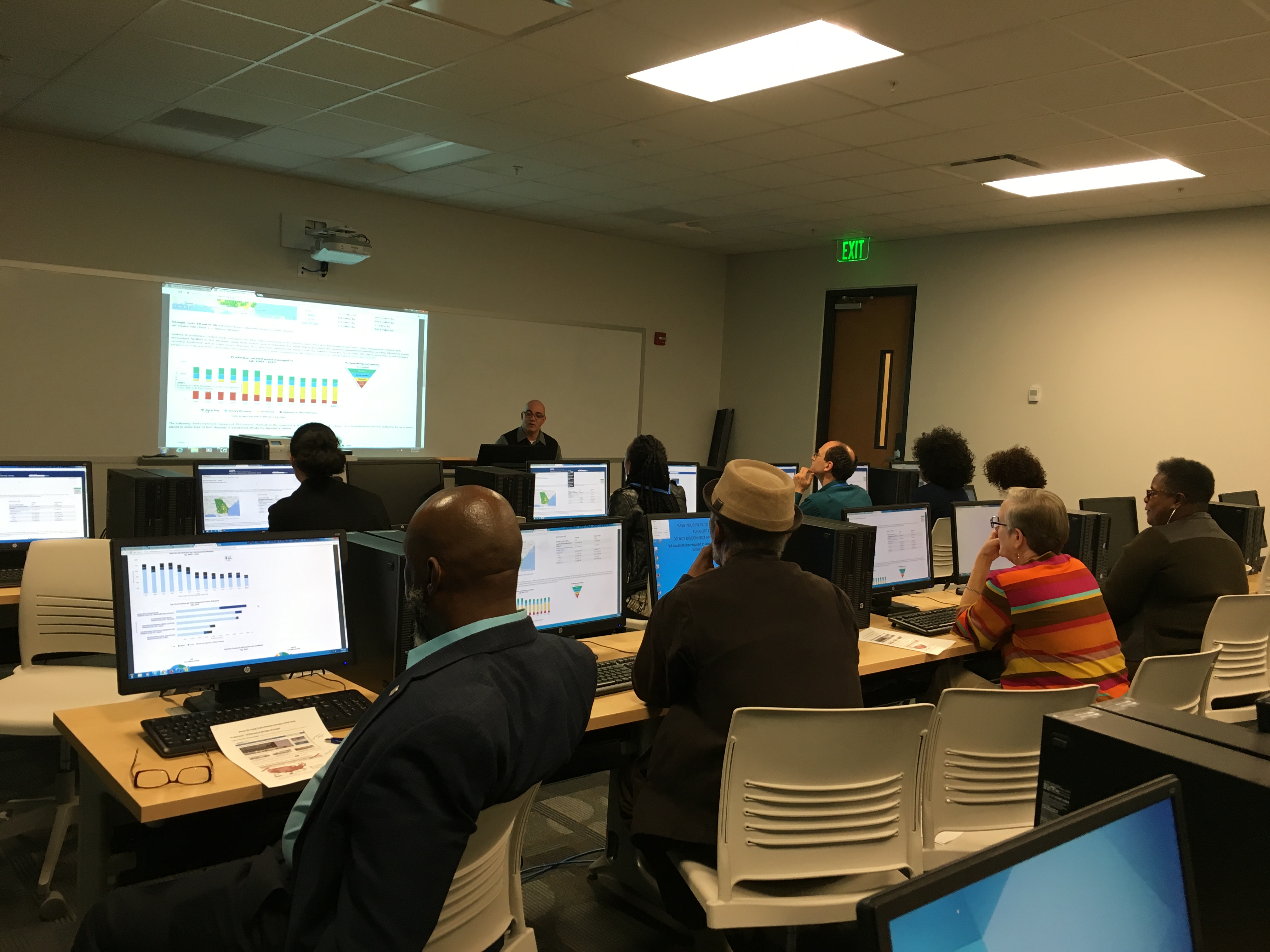Environmental Justice in Your Community
Environmental Justice Showcase Communities by Region

EPA Region 1: New England
Serving Connecticut, Maine, Massachusetts, New Hampshire, Rhode Island, Vermont and 10 Tribal Nations
The guiding principle of environmental justice is that everyone, regardless of race, color, national origin or income is entitled to equal protection from environmental harms and risks.
EPA Region 1 is committed to ensuring that environmental justice is integrated into all of our programs, policies and activities to address disproportionately high human and environmental health risks and impacts in New England communities whose residents are predominately of color, Indigenous, and/or low-income.
EPA Region 1 seeks to achieve environmental justice in New England communities by:
- Collaborating with community members, government organizations, not-for-profit organizations, academic institutions and other stakeholders to address environmental and health-related challenges
- Enhancing understanding of environmental and health-related issues at the community level
- Providing accessible and culturally appropriate opportunities for low-income, minority and linguistically isolated stakeholders to meaningfully participate in our decision-making processes
- Providing information, tools and resources to stakeholders
- Improving methods for identifying, addressing, tracking and measuring progress toward achieving environmental justice
Please contact Jeff Norcross (norcross.jeffrey@epa.gov)to receive occasional announcements about learning opportunities, funding opportunities, conferences and other environmental justice news.
Learn more about EPA Region 1.
The Healthy Communities Grant Program is EPA-Region 1’s main competitive grant program to work directly with communities to reduce environmental risks to protect and improve human health and the quality of life.
EPA’s Brownfields program has provided nearly $250 million in grants and technical assistance to New England communities, states, tribes, and other stakeholders to prevent, assess, safely clean up and sustainably reuse brownfields.
Regional EJ Resources
- Region 1 EJ Action Plan, 2021-2022 (pdf)
- Region 1 Implementation Plan to Promote Meaningful Engagement of Overburdened Communities in Permitting Activities
Regional EJ and Civil Rights Contacts
| Topic | Contact | Phone |
|---|---|---|
| Environmental Justice Program Manager |
Jeff Norcross (norcross.jeffrey@epa.gov) | 617-918-1839 |
| Attorney-Advisor for Civil Rights, Tribal and Indigenous Peoples Advisor |
Sharon Wells (wells.sharon@epa.gov) | 617-918-1007 |
EPA Region 2:
Serving New Jersey, New York, Puerto Rico, the U.S. Virgin Islands, and 8 tribal nations
EJ is a priority for EPA Region 2. The Region 2 EJ Program works to integrate the consideration of environmental justice into all of our Regional programs, functions and activities in New York, New Jersey, Puerto Rico and the U.S. Virgin Islands. Our strategy is outlined in our Regional EJ Action Plan. The Region 2 Environmental Justice Program is driven by community-based work. We provide support to various community initiatives such as EPA's Making a Visible Difference in Communities effort. We strive to interact directly with communities and work with them to address their environmental and health concerns to the best of our ability and within the scope of the Agency's authority.
Region 2 also co-leads a Regional Interagency Working Group on Environmental Justice (EJ RIWG) with the U.S. Health and Human Services based in New York. The EJ RIWG is a communities-based effort where federal partners come together to find creative solutions for some of the most economically- and environmentally-challenged areas in our region.
Region EJ Highlights
- Just one example of our community-based approach to environmental justice is a recent workshop the Region organized. With the help and partnership of the Making a Visible Difference effort, the Region 2 EJ Program successfully coordinated with state and local leaders to hold an environmental justice and education workshop in Newburgh, NY. Through the workshop, Newburgh residents and community organizations had the chance to learn, engage, discuss and build capacity to understand and address the environmental health issues that deeply impact their community.
Regional EJ Resources
- Region 2 EJ Action Plan
- Region 2 Implementation Plan to Promote Meaningful Engagement of Overburdened Communities in Permitting Activities
- Environmental Justice for CAA Permitting in Region 2
Regional EJ Contacts
| Topic | Contact |
|---|---|
| EJ and Children’s Environmental Health Coordinator | Towana Joseph (joseph.towana@epa.gov) 212-637-3866 |
EPA Region 3: Mid-Atlantic
Serving Delaware, District of Columbia, Maryland, Pennsylvania, Virginia and West Virginia
The EPA Mid Atlantic Region’s Environmental Justice (EJ) Program is managed by the Office of Communities, Tribes and Environmental Assessment (OCTEA).
OCTEA continues to lead in the development of cumulative impact analysis through a transparent, data-driven process to identify public health and environmental issues that may impact communities. OCTEA works to build capacity both internally and externally in Region 3 through outreach and education, leading trainings, facilitating discussions, and participating in national work groups. OCTEA is the point of contact for community based organizations and other environmental justice stakeholders in Region 3. OCTEA also:
- Provides expert EJSCREEN assessments
- Provides expert CJEST analysis
- Provides redlining analyses which enables the Agency to consider the impact of historic inequities
- Reviews Agency actions to ensure EJ concerns are considered
- Conducts EJ training
- Conducts outreach in underserved communities
- Manages EJ and community grants
- Serves as the conduit for information about and for underserved communities
- Provides information and encourages support of environmental justice activities throughout Region 3
Programs Activities:
- All States EJ Working Group: Since 1999, Region 3 has chaired the All States EJ Working Group, now comprised of Region’s 1-5 and their respective states. The All States EJ Working Group began by holding a face to face meeting of the EJ staff from Region 3 and the states that comprise Region 3 in June of 1999. The meeting was an information and capacity building session designed to educate and inform the attendees about Environmental Justice; as well as to encourage a further dialogue among the attendees. The session was so well received that regularly scheduled monthly conference calls were requested and have been ongoing since that time. Over time, Regions 1, 2, 4, and 5 have joined the group continuing the monthly calls and face to face sessions when possible. The calls provide a forum for discussion of issues of concern, training and capacity building opportunities, and a host of guest speaker form the states, community groups and organizations, the regions and OEJ to name a few.
- EJScreen – OCTEA conducts approximately 20,000 EJScreen reviews annually.
- National Environmental Policy Act (NEPA) EJ Reviews – OCTEA conducts EJ reviews for all NEPA matters and developed and delivers EJ training for NEPA reviewers.
- Mapping – OCTEA works with the divisions to provide desktop analysis displaying environmental and public health issues to improve decision-making
Regional EJ Highlights
- The Chester, PA Environmental Risk Study conducted in the mid-1990’s was EPA’s first cumulative impact analysis to characterize and address risk from an EJ standpoint. This document is presented to provide historical perspective.
Regional EJ Resources
- Region 3 Implementation Plan to Promote Meaningful Engagement of Overburdened Communities in Permitting Activities
- CAA Permitting in EPA Region 3
Regional EJ Contacts
| Topic | Contact | Phone |
|---|---|---|
| OCTEA | Samantha Phillips Beers (beers.samantha@epa.gov) | 215-814-2627 |
| EJ Coordinator (Acting) | Tom Cinti (cinti.thomas@epa.gov) | 215-814-2634 |
| GIS/EJSCREEN/EJ | Angus Welch (welch.angus@epa.gov) | 215-814-2910 |
| Children's Health | Erin Sullivan (sullivan.erinc@epa.gov) | 215-814-5564 |
| Public Health | Carol Ann Gross Davis (gross-davis.carolann@epa.gov) | 215-814-5738 |
| Environmental Education | Stephanie Branche (branche.stephanie@epa.gov) | 215-814-5556 |
| State Recognized Tribes |
Barbara Okorn (okorn.barbara@epa.gov) |
215-814-3330 |
EPA Region 4: Southeast
Serving Alabama, Florida, Georgia, Kentucky, Mississippi, North Carolina, South Carolina, Tennessee and 6 Tribes
The Environmental Justice, Community Health and Environmental Review Division (EJCHERD) reports to the Regional Administrator and Deputy Regional Administrator. It plays a critical role in leading and coordinating the region’s environmental justice programs.
The vision of EJCHERD’s Environmental Justice Coordination and Community Engagement Branch (EJCCEB) is to ensure that the citizens and communities who reside in the eight States and six Tribes in EPA Region 4, have equitable access to clean water, clean air, and clean land while analyzing and addressing disproportionate impacts including distribution of environmental burdens and benefits. The program focuses on communities of color, low-income communities, Indigenous peoples, and vulnerable, overburdened and/or disadvantaged communities. The eight States and six Tribes served are: Alabama, Florida, Georgia, Kentucky, Mississippi, North Carolina, South Carolina, Tennessee, as well as six federally recognized Tribes (i.e., Catawba Indian Nation, Eastern Band of Cherokee Indians, Miccosukee Tribe of Indians of Florida, Mississippi Band of Choctaw Indians, Poarch Band of Creek Indians, Seminole Tribe of Florida.)
In addition to working with external stakeholders, EJCCEB works closely with the EPA Region 4 Divisions in their integration of environmental justice within their programs. The EJCCEB plays the following role while working internally with EPA Region 4 Divisions and/or with external stakeholders (i.e., States, Tribes, and Local Governments, community-based organizations, academia, non-profits, etc.): Advisory; Consultative; Convening; Collaborative; Training (internal & external partners) and Technical Assistance/Support. In addition, the EJCCEB now has an advisory role in supporting the EPA Region 4’s EJ Advisory Council comprised of senior managers.
Regional EJ Contacts
| Topic | Contact | Phone |
|---|---|---|
| Manager, EJ Programmatic Coordination and Grants Section | Brian Holtzclaw (holtzclaw.brian@epa.gov) | 404-562-8684 |
| Manager, EJ Capacity Building and Grants Section (Acting) | Jeannie Williamson (Williamson.Jeannie@epa.gov) | 404-562-9402 |
| EJ Coordinator (Acting) and EJ Specialist (Tennessee) | Sheryl Good (good.sheryl@epa.gov) | 404-562-9559 |
| EJ Specialist (South Carolina, Florida; Grants Coordinator) | Daphne Wilson (wilson.daphne@epa.gov) | 404-562-9098 |
| EJ Specialist (Mississippi, North Carolina) | Kyle Bryant (bryant.kyle@epa.gov) | 404-562-9073 |
| EJ Specialist (Alabama) | Ferry Akbar Buchanan (AkbarBuchanan.Ferry@epa.gov) | 404-562-9482 |
| EJ Specialist (Georgia) | Beck Miguel Saunders-Shultz, SaundersShultz.BeckMiguel@epa.gov) | 404-562-8901 |
| EJ Specialist (Kentucky, Tribal) | Nancye Elizabeth Sovine (‘Elle’), Sovine.Nancye@epa.gov) | 404-562-9082 |
Key Code: ORA = Office of Regional Administrator; GMD = Gulf of Mexico Division; ECAD = Enforcement Compliance Assistance Division; ARD = Air Radiation Division; SEMD = Superfund Emergency Response Division; LSASD = Laboratory Services and Applied Sciences Division; WD = Water Division; LCRD = Land, Chemicals and Redevelopment Division; ORC = Office of Regional Counsel; MSD = Mission Support Division.
Photo Gallery
EPA Region 5: Great Lakes
Serving Illinois, Indiana, Michigan, Minnesota, Ohio, Wisconsin and 35 tribes
Region 5’s Environmental Justice Program is located in the Tribal and Multimedia Programs Office, within the Office of the Regional Administrator. We work across Region 5’s programs, in collaboration with a wide range of partners and stakeholders. Our purpose is to make transformative progress in advancing environmental justice and equity at the Tribal, state, and local levels, through a whole-of-government approach that involves communities as authentic partners.
Region 5 EJ Highlights
Working in and with communities to address disproportionate and cumulative impacts
- Standard Operating Procedure for the Community Action Roadmap (pdf)
- Region 5 Community Action Roadmap (pdf)
- Cahokia Heights Drinking Water
- Communities in the East St. Louis Area and Sanitary Sewer Overflows
- Environmental Issues in Southeast Chicago
- Environmental Issues in Little Village & Pilsen
- Benton Harbor Drinking Water
- EPA in Detroit and Downriver Communities
- Flint Drinking Water Response
Increasing awareness, engagement, and partnerships
- EPA is co-presenting an EJ Academy with The Kapal Foundation (Kappa House) and Southern Illinois University Edwardsville
- EPA co-presented an EJ Academy with the Miami Valley Regional Planning Commission in Ohio this past year, with support from local business partners and the University of Dayton among others.
- EPA joined other federal agencies to hold the Midwest Region Lead Workgroup Webinar, providing resources that could be leveraged to address various forms of lead contamination.
EJ for Permitting Activities in Region 5
- Environmental Justice in CAA Permitting in EPA Region 5
- Region 5 Implementation Plan to Promote Meaningful Engagement of Overburdened Communities in Permitting Activities
Regional EJ Contacts
Region 5 works across all programs and divisions to advance and integrate environmental justice.
| Topic | Contact | Phone |
|---|---|---|
| EJ Program Manager | Alan Walts (walts.alan@epa.gov) | (312) 353-8894 |
| EJ Coordinator | Kathy Triantafillou (triantafillou.kathy@epa.gov) |
(312) 353-4293 |
| EJ Tribal and Indigenous Peoples Advisor | Tina Davis (davis.tina@epa.gov) | (312) 353-8254 |
| Air | Monica Paguia (paguia.monica@epa.gov) | (312) 353-1166 |
| Brownfields Redevelopment | Brittney Nadler (nadler.brittney@epa.gov) | (312) 886-5740 |
| Children's Health | Elizabeth Poole (poole.elizabeth@epa.gov) | (312) 353-2087 |
| Enforcement | Francene Harris (harris.francene@epa.gov) | (312) 886-3512 |
| Environmental Education | Megan Gavin (gavin.megan@epa.gov) | (312) 353-5282 |
| Great Lakes | Erica Sheeran (sheeran.erica@epa.gov) | (312) 886-6098 |
| School Assistance Center | Kara Belle (belle.kara@epa.gov) | (312)353-9236 |
| Superfund | Jamie Stoik (stoik.jamie@epa.gov) | (312) 886-6069 |
| Water | Khalia Poole (poole.khalia@epa.gov) | (312) 353-4194 |
State Environmental Agencies
Region 5 works with state environmental agencies to advance environmental justice and equity.
| Agency | Agency Website |
|---|---|
| Illinois Environmental Protection Agency | |
| Indiana Department of Environmental Management | |
| Michigan Department of Environment, Great Lakes, and Energy | |
| Minnesota Pollution Control Agency | |
| Ohio Environmental Protection Agency | |
| Wisconsin Department of Natural Resources |
EPA Region 6: South Central
Serving Arkansas, Louisiana, New Mexico, Oklahoma, Texas and 66 Tribal Nations
The Office of Environmental Justice, Tribal, and International Affairs works closely with communities to facilitate culturally sensitive communication, find solutions, or reduce environmental challenges. The Environmental Justice program’s goal is to ensure that all people are protected from disproportionate impacts of environmental hazards by working with and on behalf of impacted communities.
Environmental Justice is about real people facing real problems and designing practical solutions to address challenging environmental issues. The environmental justice movement advocates programs that promote environmental protection within the context of sustainable development. The Environmental Justice program administers EJ Small Grants and EJ Collaborative Problem-Solving (CPS) Cooperative Agreement Program.
Regional EJ Resources
- Region 6 Implementation Plan to Promote Meaningful Engagement of Overburdened Communities in Permitting Activities
- Environmental Justice for CAA Permitting in EPA Region 6
- The Merger of Small Water Systems is one of several presentations from the EPA Region 6 Environmental Justice Forum in June 2018; it details a best practice model in southern New Mexico that effectively brought about improved access to clean water.
Regional EJ Contacts
| Topic | Contact | Phone |
|---|---|---|
| Acting Director, Office of Communities, Tribes and Environmental Assessment | Eunice Varughese | 513-569-7628 |
| EJ NEPA/EJScreen Coordinator | Agatha Benjamin | 214-665-7292 |
| EJ Liaison - Environmental Education Grants | Alexa Olson | 214-665-8506 |
| EJ Liaison | Chad Larsen | 214-665-8058 |
EPA Region 7: Midwest
Serving Iowa, Kansas, Missouri, Nebraska and Nine Tribal Nations
The primary focus of the Region 7 Environmental Justice Program is to ensure that, as a Region, we are fulfilling the mandate given in Executive Order 12898 on environmental justice.
Fulfilling this mandate means ongoing efforts to both ensure that Region 7 is addressing environmental justice in all we do and ensure community awareness regarding environmental issues and the decision-making processes in areas which affect their daily lives. The program maintains its outreach and education activities where grants programs and Agency participation in community activities have produced tangible environmental benefits for low-income and minority communities.
Our Vision
- Meaningful involvement of low-income and minority populations in our decision-making processes.
- Greater understanding of environmental and health-related issues at the community level.
- The ability to identify, address, track and measure Region 7's progress towards ensuring environmental justice at sites located in low-income and communities of colors.
- Collaboration with federal, state and local governments, not-for-profit organizations, academic institutions, and other stakeholders to ensure environmental justice.
Regional EJ Highlights
- Region 7 Health Homes Community Initiative
Regional EJ Resources
- Region 7 Implementation Plan to Promote Meaningful Engagement of Overburdened Communities in Permitting Activities
- Environmental Justice for CAA Permitting in EPA Region 7
Regional EJ Contacts
| Topic | Contact |
|---|---|
| EJ Coordinator | Monica Espinosa (Espinosa.Monica@epa.gov) |
| Acting Communities Section Chief | LaTonya Sanders (Sanders.Latonya@epa.gov) |
EPA Region 8: Mountains and Plains
Serving Colorado, Montana, North Dakota, South Dakota, Utah, Wyoming, and 28 Tribal Nations
Region 8’s environmental justice program is focused on ensuring that everyone in Region 8 has the same degree of protection from environmental and health hazards, and equal access to the decision-making process to have a healthy environment in which to live, learn, and work. Region 8’s EJ Team works to advance environmental justice by supporting underserved communities through connecting with, supporting, building the capacity of, and leveraging resources from both internal and external partners.
Region 8 is predominantly rural and home to traditionally disenfranchised and historically self-reliant communities including Tribal Nations and Indigenous Peoples, migrant farm workers, Hispanic communities, and rural low income communities.
The Region 8 EJ Team’s principal focus areas are to effectively integrate environmental justice into the activities of EPA Region 8, build effective partnerships with external stakeholders, and respond to challenges faced by overburdened communities in the Region.
Region EJ Highlights
The following is an example of a key effort in Region 8 aimed at benefitting the Region’s communities with environmental justice concerns:
- Serving Overburdened Communities in Commerce City – North Denver: Members of the Commerce City – North Denver, Colorado community have expressed concerns regarding the health of their environment and community. Using federal authorities and leveraging partnerships with State and local governments and nongovernmental organizations, U.S. Environmental Protection Agency (EPA) staff is actively working to address the community’s concerns to ensure protection of human health and the environment. Learn more here.
- Salt Lake City, Utah Westside Neighborhoods EJ Assessment: In response to requests from community members and the Mayor of Salt Lake City (SLC) related to concerns about disproportionate impacts to air quality and plans for an inland port in the six Westside neighborhoods of SLC, EPA provided funding for a targeted environmental justice assessment for the area. This assessment report is a resource for community groups, local governments, the port authority and other stakeholders as they consider how future development and operations may further impact air quality and public health. The six Westside neighborhoods considered in this assessment are Westpointe, Jordan Meadows, Poplar Grove, Glendale, Fairpark and Rose Park. The assessment was conducted through the EPA’s Technical Assistance Services for Communities (TASC) program in collaboration with representatives from the SLC sustainability office, local organizations, and the Westside community.
Regional EJ Resources
- Region 8 Implementation Plan to Promote Meaningful Engagement of Overburdened Communities in Permitting Activities
- Environmental Justice for CAA Permitting in EPA Region 8
Regional EJ Contacts
| Topic | Contact |
|---|---|
| Children’s Health, Environmental Justice, and Equity Branch Manager | David Dorian (dorian.david.i@epa.gov) |
| EJ Grants Assistance Section Supervisor (Acting) | Blake Huff (huff.blake@epa.gov) |
| EJ Tribal and Indigenous Peoples Advisor | Kimberly Varilek (varilek.kimberly@epa.gov) |
EPA Region 9: Pacific Southwest
Serving Arizona, California, Hawaii, Nevada, Pacific Islands and 148 Tribes
EPA Region 9 supports programs and projects to help address adverse and disproportionate effects. Here you will find examples of the ways communities have used EPA funding to increase their capacity to improve their local environment. We have also provided a list of tools and resources that may be useful to environmental justice organizations and residents.
Regional EJ Highlights
- Presentation Slides: October 2024 EPA Region 9 Virtual Environmental Justice (EJ) Monthly Community Check-In | Diapositivas de la presentación: Registro comunitario mensual virtual de justicia ambiental (EJ) de la región 9 de la EPA de octubre de 2024 (pdf)
- Presentation: September 2024 EPA Region 9 Virtual Environmental Justice (EJ) Monthly Community Check-In | Presentación: Registro comunitario mensual virtual de justicia ambiental (EJ) de la región 9 de la EPA de septiembre de 2024 (pdf)
- Presentation: August 2024 EPA Region 9 Virtual Environmental Justice (EJ) Monthly Community Check-In | Presentación: Registro comunitario mensual virtual de justicia ambiental (EJ) de la región 9 de la EPA de agosto de 2024 (pdf)
- Presentation: EPA Region 9 Hawaii Hybrid Environmental Justice (EJ) Community Check-In (CCI) Session (pdf)
- Presentation: July 9, 2024, EPA Region 9 Virtual Environmental Justice (EJ) Monthly Community Check-In | Presentación: 9 de julio de 2024, Registro comunitario mensual de justicia ambiental virtual (EJ) de la Región 9 de la EPA (pdf)
- Presentation: May 2024 Monthly Community Check-In | Presentación: Registro comunitario mensual de mayo de 2024 (pdf)
- Presentation: February 2024 Monthly Community Check-In | Presentación: Registro comunitario mensual de febrero de 2024 (pdf)
- EPA Region 9 Environmental Justice and External Civil Rights Implementation Plan for Fiscal Year 2024 - Virtual Engagement: Summary of Key Public Comments, Questions, and Concerns (pdf)
- Agencia de Protección Ambiental de EE. UU., Plan de Implementación de Justicia Ambiental y Derechos Civiles Externos de la Región 9 para el año fiscal 2024 - Participación virtual: Resumen de comentarios, preguntas e inquietudes principales del público (pdf)
- Environmental Justice and External Civil Rights Implementation Plan - Fiscal Year 2023 - Region 9 (pdf)
- Plan de Implementación de Justicia Ambiental y Derechos Civiles Externos - Año Fiscal 2023 - Región 9 (pdf)
- EPA Presentation: Region 9's EJ and Civil Rights Plan Overview | Diapositivas de la presentación: Descripción del Plan de Derechos Civiles y EJ de la Región 9 de la EPA (pdf)
- U.S. Environmental Protection Agency, Region 9 Environmental Justice and External Civil Rights Implementation Plan for Fiscal Year 2023 - Virtual Engagement: Summary of Key Public Comments, Questions, and Concerns (pdf)
- Agencia de Protección Ambiental de EE. UU., Plan de Implementación de Justicia Ambiental y Derechos Civiles Externos de la Región 9 para el año fiscal 2023 - Participación virtual: Resumen de comentarios, preguntas e inquietudes principales del público (pdf)
- Region 9 Environmental Justice Small Grants Success Stories
- Los Angeles Area Environmental Enforcement Collaborative
- Contact Morgan Capilla to receive Region 9 EJ updates. EPA's Pacific Southwest Environmental Justice Program sends occasional updates (funding opportunities, conferences, events, and other relevant information) and has a monthly community check-in call the third Tuesday of the month to engage with communities.
Regional EJ Resources
- The FY2015 EJ Action Plan continues the process begun in 2014, with each Region 9 Division responsible for integrating EJ into its work. The new region-wide EJ Network develops and follows through on shared EJ commitments in places and projects, based on our permitting and enforcement initiatives and the use of EJSCREEN, EPA's nationally consistent screening tool for environmental justice.
- Environmental Justice for CAA Permitting in EPA Region 9
Regional EJ Contacts
Do you have a program-specific question about Environmental Justice? Check out the list of network members below and the EJ-related topics of interest they are knowledgeable about. If you don’t find what you’re looking for, please contact the EJ Coordinator.
| Topic | Contact |
|---|---|
| EJ Coordinator | Morgan Capilla (capilla.morgan@epa.gov) |
EPA Region 10: Pacific Northwest
Serving Alaska, Idaho, Oregon, Washington and 271 Native Tribes
Region 10's environmental justice program works to integrate the principles of environmental justice throughout the four states of Idaho, Alaska, Oregon and Washington. This is accomplished through grantmaking, direct collaboration with communities and tribes, close coordination with states and other governmental agencies and participation with universities, research centers and other entities involved in extending the discourse on environmental justice.
The program also prioritizes the integration of environmental justice within the Region 10 office through strategic planning, training and working across programs on the Agency’s core work of permitting, enforcement, Superfund and other functions.
Region 10's environmental justice program is currently located in the Policy and Environmental Review Branch in the Office of the Regional Administrator.
You can find examples of previously funded environmental justice projects in Region 10 by exploring the map at Environmental Justice Program Funded Projects.
Regional EJ Highlights
- EPA Region 10 Environmental Justice Grants Outreach Series - September/October 2022
Regional EJ Contacts
| Topic | Contact | Phone |
|---|---|---|
| Manager | Rebecca Chu (chu.rebecca@epa.gov) | 206-553-1774 |
| EJ Senior Advisor | Derrick Terada (terada.derrick@epa.gov) | 206-553-4768 |
| EJ Coordinator & Alaska Lead | Alessandro Molina (molina.alessandro@epa.gov) | 206-553-2724 |
| EJ Program Specialist - Grants Lead | Sydney Hurst (hurst.sydney@epa.gov) | 206-553-1060 |
| EJ Program Specialist - Idaho Lead | Emily Good (good.emily@epa.gov) | 208-378-5760 |
| EJ Program Specialist - Oregon Lead | Scott Schlief (schlief.scott@epa.gov) | 206-553-4032 |
| EJ Program Specialist - Outreach Lead & Washington Lead | Debra Neal (neal.debra@epa.gov) | 206-553-1465 |
| EJ Program Specialist - Participatory Science Liaison | Martha Scott Tomlinson (tomlinson.marthascott@epa.gov) | 206-553-8696 |
| NEPA EJ Program Liaison | Emily Bitalac (bitalac.emily@epa.gov) | 206-553-2581 |









